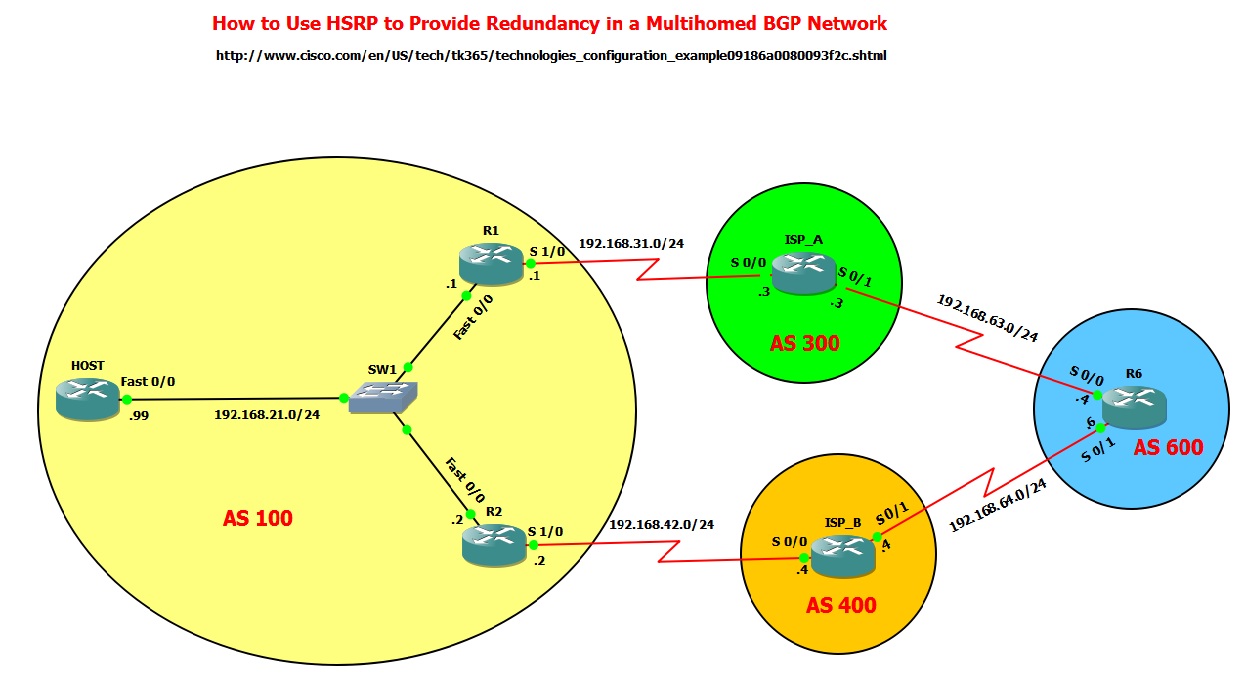- Cisco Community
- Technology and Support
- Networking
- Routing
- Multihomed BGP - Who will advertise directly connected networks?
- Subscribe to RSS Feed
- Mark Topic as New
- Mark Topic as Read
- Float this Topic for Current User
- Bookmark
- Subscribe
- Mute
- Printer Friendly Page
- Mark as New
- Bookmark
- Subscribe
- Mute
- Subscribe to RSS Feed
- Permalink
- Report Inappropriate Content
06-08-2013 12:25 PM - edited 03-04-2019 08:08 PM
I am labing-up a scenario on my GNS3 from Cisco's site to practice HSRP, BGP and maybe grow the network later on to practice other protocols as well.
http://www.cisco.com/en/US/tech/tk365/technologies_configuration_example09186a0080093f2c.shtml
Everything is already configred and setup, except I don't have any interconnects routes advertized to any BGP processes on any routers, yet.
Interconnect networks as you cna see from the photo are:
192.168.31.0
192.168.42.0
192.168.63.0
192.168.64.0

Obviously I cannot source these networks from every router, nor use redistribute connected on every router because I would get duplicate routes, so my question is: which routers would you use to originate these 4 networks from? I was thinking to use network command (or maybe even a route map) on ISPA for 192.168.31.0 and 192.168.63.0 networks, and ISPB for 192.168.42.0 and 192.168.64.0 networks.
What is the proper real world method for something like this, or there are more ways to do it properly?
Thanks in advance
Solved! Go to Solution.
- Labels:
-
Routing Protocols
Accepted Solutions
- Mark as New
- Bookmark
- Subscribe
- Mute
- Subscribe to RSS Feed
- Permalink
- Report Inappropriate Content
06-09-2013 10:16 AM
Hi Vanjaburic,
RIB failure is not an issue. You will see such output normally in case BGP route is not able to get installed in to routing table because a route with higher AD value is already there in routing table. Here we have static route.
more information on BGP RIB failure
http://blog.ioshints.info/2007/12/what-is-bgp-rib-failure.html
- The RIB failure feature was introduced in IOS release 12.2T; prior to that, the BGP routes with higher administrative distance than other route sources were silently ignored (similar to all other routing protocols).
- You can display BGP routes that are not inserted in the IP routing table with theshow ip bgp rib-failure command, which also explains why the BGP route was not inserted in the IP routing table.
- The BGP routes that are not used due to higher administrative distance are still advertised to all BGP peers (contrary to what most other distance-vector routing protocols do), unless you configure bgp suppress-inactive (introducted in 12.2T and 12.0(26)S).
Regards,
Akash
- Mark as New
- Bookmark
- Subscribe
- Mute
- Subscribe to RSS Feed
- Permalink
- Report Inappropriate Content
06-08-2013 10:23 PM
Hi Vanjaburic,
Normally what i have seen is, ip address of interconnect links belongs to upstream service provider. In the given scenario, network 192.168.31.0/24 and 192.168.63.0/24 would belong to ISP-A and 192.168.42.0/24 and 192.168.64.0/24 would belong to ISP-B. In real world we also dont need to advertise the interconnect wan ip into BGP because routing for actual destination is never dependent on these wan ips, but it could be part of a major network which is already advertised into internet by ISP.
Regards,
Akash
- Mark as New
- Bookmark
- Subscribe
- Mute
- Subscribe to RSS Feed
- Permalink
- Report Inappropriate Content
06-09-2013 08:28 AM
Thanks for the reply Akash. If I don't advertize those interconnects into BGP, then R1 and R2 won't be able to reach 192.168.63.0 and 192.168.64.0 networks. But if I do advertize them then I am runing into another probolem:
On routers R1 and R2 I am getting RIB failure because those networks are now known via BGP instead of directly connected.
R1:
R1#show ip bgp rib-failure
Network Next Hop RIB-failure RIB-NH Matches
192.168.31.0 192.168.31.3 Higher admin distance n/a
R2:
R2#show ip bgp rib
Network Next Hop RIB-failure RIB-NH Matches
192.168.42.0 192.168.42.4 Higher admin distance n/a
on R6 as well
R6#show ip bgp rib-failure
Network Next Hop RIB-failure RIB-NH Matches
192.168.63.0 192.168.63.3 Higher admin distance n/a
192.168.64.0 192.168.64.4 Higher admin distance n/a
- Mark as New
- Bookmark
- Subscribe
- Mute
- Subscribe to RSS Feed
- Permalink
- Report Inappropriate Content
06-09-2013 10:16 AM
Hi Vanjaburic,
RIB failure is not an issue. You will see such output normally in case BGP route is not able to get installed in to routing table because a route with higher AD value is already there in routing table. Here we have static route.
more information on BGP RIB failure
http://blog.ioshints.info/2007/12/what-is-bgp-rib-failure.html
- The RIB failure feature was introduced in IOS release 12.2T; prior to that, the BGP routes with higher administrative distance than other route sources were silently ignored (similar to all other routing protocols).
- You can display BGP routes that are not inserted in the IP routing table with theshow ip bgp rib-failure command, which also explains why the BGP route was not inserted in the IP routing table.
- The BGP routes that are not used due to higher administrative distance are still advertised to all BGP peers (contrary to what most other distance-vector routing protocols do), unless you configure bgp suppress-inactive (introducted in 12.2T and 12.0(26)S).
Regards,
Akash
- Mark as New
- Bookmark
- Subscribe
- Mute
- Subscribe to RSS Feed
- Permalink
- Report Inappropriate Content
06-10-2013 06:13 PM
Thanks for the reply. I did not know that RIB failure is not an issue. That makes more sense now. Because no matter what router I used to advertize those interconnects with, I would have encountered RIB failure.
Find answers to your questions by entering keywords or phrases in the Search bar above. New here? Use these resources to familiarize yourself with the community:
